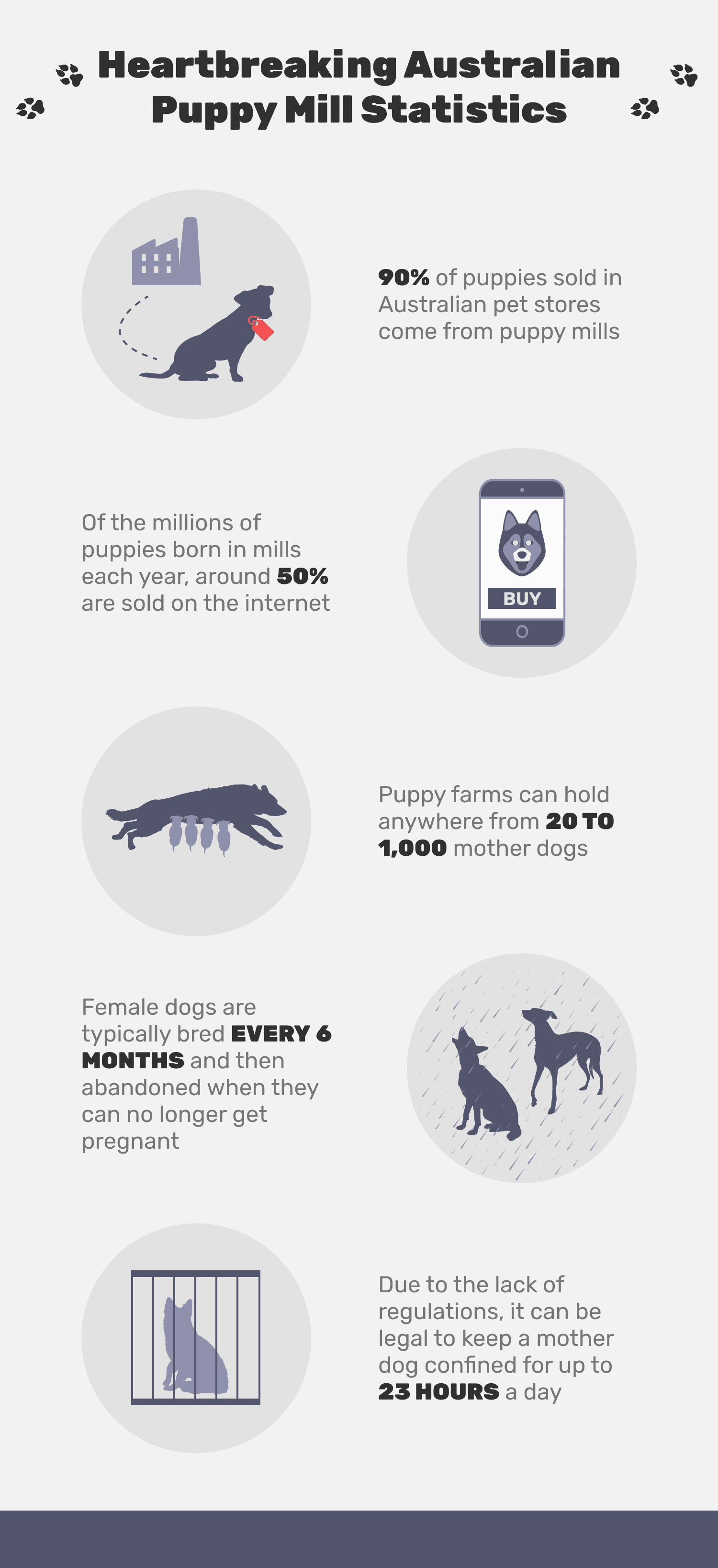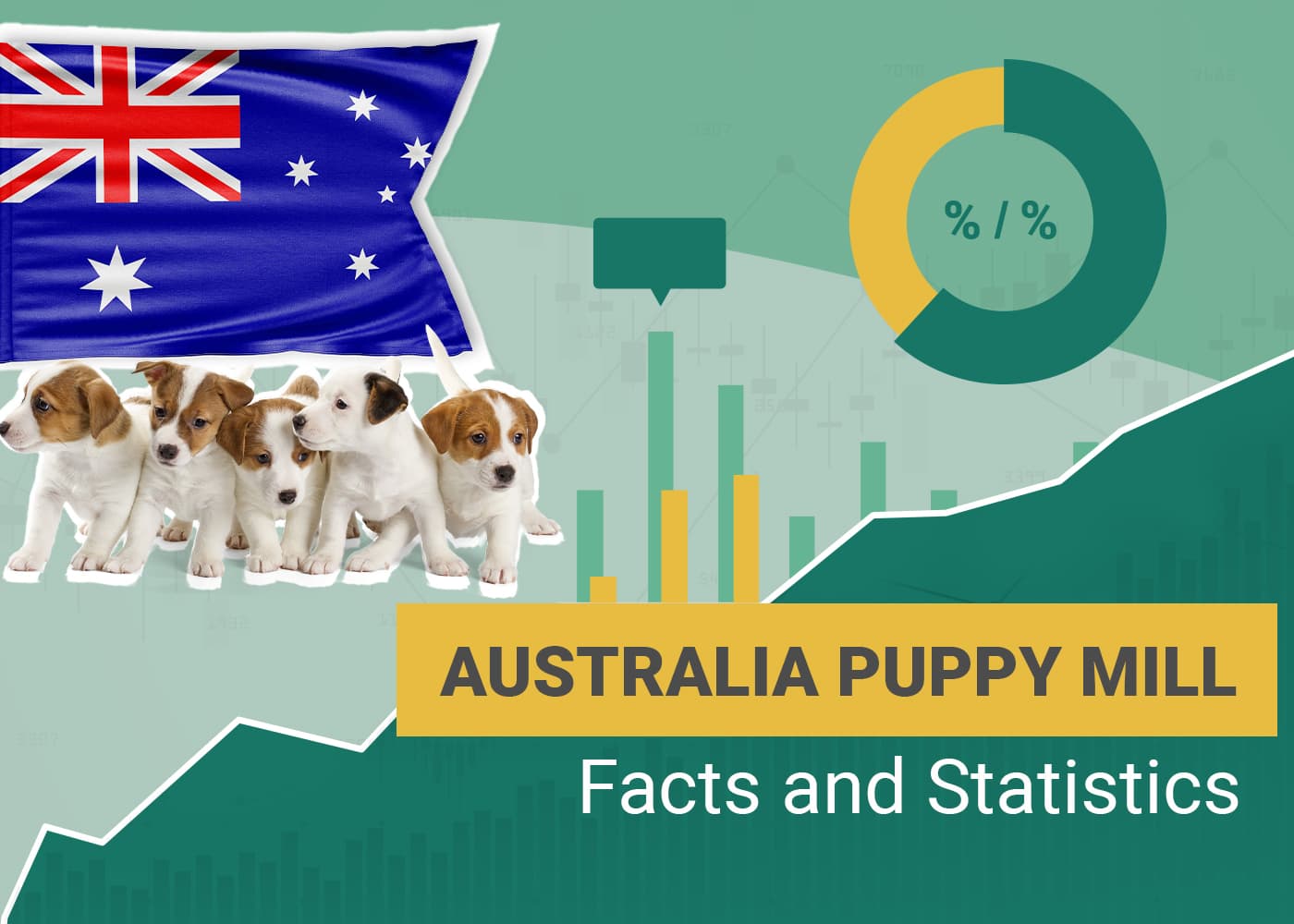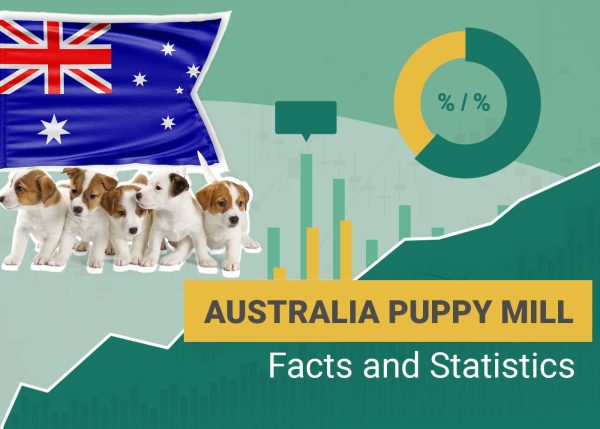Click to Skip Ahead
Note: This article’s statistics come from third-party sources and do not represent the opinions of this website.
The dogs forced to breed in puppy mills won’t ever live the carefree, loving lives they deserve. These animals will never run on the beach, chase a stick, or snuggle up on the couch with someone who loves them at night. Dogs are deprived of all companionship in these puppy factories and are treated like machines rather than actual living things.
Australia has had significant issues with these puppy mills with the demand for puppies keeping these businesses running, plus, there are few consequences and laws in place to give these animals a better life.
This article gives you some of the most heartbreaking statistics about Australian puppy mills. Be warned— some of them could have you shedding a few tears.
Top 11 Australian Puppy Mill Statistics
- Roughly 5 million out of 7.5 million Australian households have animal companions.
- Of the millions of puppies born in mills, half of them are sold on the internet each year.
- 90% of puppies sold in Australian pet stores come from puppy mills.
- Around 450,000 puppies are sold in Australia each year.
- 15% of puppies are sold through pet shops, with the majority of sales being done online.
- 200,000 healthy cats and dogs are euthanized every year in Australia.
- Puppy farms can hold anywhere from 20 to 1,000 mother dogs.
- It can be legal to keep a mother dog confined for up to 23 hours a day.
- Female dogs are typically bred twice per year and then killed or abandoned when they can no longer get pregnant.
- The Dog Amendment Bill was passed in 2021 to better regulate breeding in Western Australia.
- Victoria is the only state in Australia with legislation associated with puppy farming.

The Sale of Puppies in Australia
1. Roughly 5 million out of 7.5 million Australian households have animal companions.
(ALQ)
Animal companions are a huge part of Australian culture. Over two-thirds of the homes in Australia currently have some sort of pet, with dogs and cats being a vast majority of those animals. The companion animal industry is so large that it generates about $8 billion in profit every year.

2. Of the millions of puppies born in mills, an estimated half of them are sold on the internet each year.
(PETA)
The sale of puppy mill dogs online is a huge issue. The government often doesn’t care about the victims that are sent out of state, and there are no laws in place to fine or punish the breeders. They continue to make money pumping out puppies without facing any consequences.
3. 90% of puppies sold in Australian pet stores come from puppy mills.
(OurDogs)
Even if you think purchasing a dog from a pet store is better than from a puppy mill, you could be wrong. Almost all pet stores in Australia sell dogs that come directly from puppy factories. If you’ve never been informed of these dogs’ backgrounds, then you might be thinking you’re buying from reputable breeders without realizing that you’re still unknowingly contributing to the problem.

4. Around 450,000 puppies are sold in Australia each year.
(AnimalsAustralia)
Does it come as a surprise that so many puppies are sold in Australia each year? The demand for pets is continuously rising, and it shows no signs of stopping. This gives puppy mills even more incentive to continue running and growing their businesses.
5. 15% of puppies are sold through pet shops, with the majority of sales being done online.
(AnimalsAustralia)
The problem with selling dogs online is that you have no way of visiting the breeder to ensure they treat their animals properly. Plus, the puppies could get sold to complete strangers with no intention of treating the dogs properly.

The True Victims of Puppy Mills
6. 200,000 healthy cats and dogs are euthanized every year in Australia.
(PETA)
Similar to the United States, it likely doesn’t come as a surprise that Australia euthanizes plenty of healthy cats and dogs every single year. This is because these dogs have no place to call home and are often abandoned for no reason.
7. Puppy farms can hold anywhere from 20 to 1,000 mother dogs.
(PETA)
The biggest victims of puppy mills are the mother dogs. These dogs are treated more like cattle, and their bodies are used to constantly pump out litters of puppies while being kept in horrendous conditions. Sometimes, the mothers are pregnant before they are even 6 months old and only kept if they continue to be profitable.

8. It can be legal to keep a mother dog confined for up to 23 hours a day.
(AnimalsAustralia)
The conditions that these animals are kept in are truly horrifying. Dogs are kept in confined areas nearly all day. They are deprived of grooming, socialization, and exercise, and it’s not unlikely to see them covered in their own filth. It can actually be legal to keep thousands of dogs on a property as long as they are given food and water. There are not many other regulations against the way the animals are treated.
9. Female dogs are typically bred twice per year and then killed or abandoned when they can no longer get pregnant.
(PETA)
The mother dogs are only kept at the puppy mill while they are profitable. If they can no longer get pregnant, it is common to either kill or abandon them. The moms and their litters are usually malnourished and not given any veterinary care.
Future Outlook on Australian Puppy Mills
10. The Dog Amendment Bill was passed in 2021 to better regulate breeding in Western Australia.
(DLGSC)
Since conditions are so horrible, it makes us question whether any action is being taken against these abusive factories. A bill was passed last year to help regulate the breeding taking place in Western Australia, although many of the changes will still take time to be in effect. Some of the things this bill mandates are centralized registration systems, regulation on the number of dogs being bred, and more.
11. Victoria is the only state in Australia with legislation associated with puppy farming.
(AnimalsAustralia)
Unfortunately, Victoria is still the only state in the country to mitigate many of the problems with puppy farming, although there are still cruel acts here that are completely legal. Some mills are still operating within the regulations and treating animals poorly. We can only hope that these new bills continue to spread across the country and become regularly enforced.
Frequently Asked Questions
How do I tell if my dog is from a puppy mill?
- They don’t share information about the puppy’s parents or background.
- Breeders don’t allow you to see the kennel.
- The breeders focus on more than one breed.
- The mill doesn’t require you to sign any paperwork.
- The dog has not had its shots or any sign of medical care.
- They sell the dogs while they are only a few weeks old.
What can I do to stop supporting puppy mills?
The biggest change you can make when looking to buy a new dog is to adopt instead of shop. Likewise, you can report any animal cruelty, speak out against pet shops and mills, and educate your children about the dangers of puppy farming.
Why are puppy mills so bad?
Puppy mills raise dogs under horrible conditions. The dogs also have poor genetics and go through stress from being taken away from their mothers while being too young. Many times, the issues these dogs have are hard to treat, and owners often abandon them because they can’t fix the problems.
Do puppy mills kill the dogs? If so, how?
There are times when puppy mills will kill dogs that are either sick or no longer able to get pregnant and are unprofitable. Most puppy mill owners will kill the dogs themselves on their property.
Conclusion
It’s heartbreaking to know that there are millions of dogs around the world being treated so poorly. Each one deserves to be loved as you’d love your own dog. Unfortunately, until more laws are put into place and enforced, the demand for puppies will keep the mills up and running. While there isn’t a way to shut all puppy mills down in Australia, there are ways that you can speak out and stand up against the cruelty these animals face.
We hope that these statistics regarding Australian puppy mills have opened your eyes to the abuse that some dogs are put through. We can only hope that these dogs are released to good homes where they are treated with compassion and companionship.
Featured Image Credit: 2690457, Pixabay












